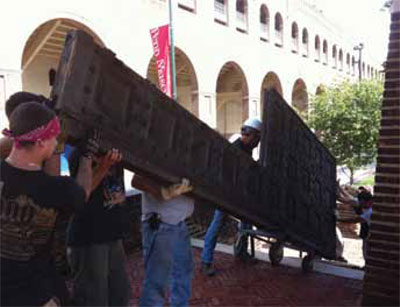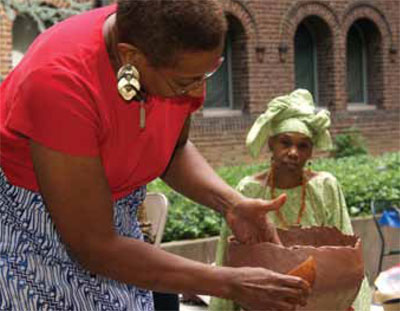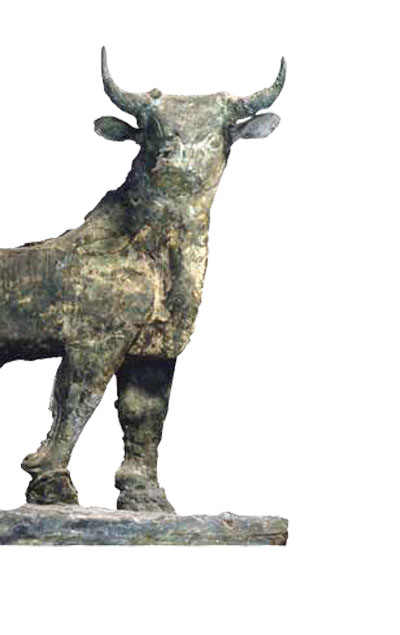Renovations of the Museum’s Original Wing Continue

Following the installation of a climate-control system and the renovation of the gallery housing the long-term exhibition Iraq’s Ancient Past in fall 2010, restoration of the other four galleries in the Museum’s West Wing, including new windows, millwork, and radiator covers, took place this fall. Generous support was received for renovations to the William B. Dietrich Gallery from the William B. Dietrich Foundation; for enhancements to the lighting systems in all five galleries from William and Judith Bollinger; for general renovations from the 1956 Otto Haas Charitable Trust; and for window replacement from Penn’s Facilities Renewal Fund.

Museum Introduces Imagine Africa Community Outreach Initiative
In September 2011, the Penn Museum launched Imagine Africa with the Penn Museum, a year-long community outreach initiative and interactive gallery experience. The program includes a series of engaging events, live performances by local dancers and musicians, artist demonstrations and workshops, free community evenings, and sustained public school outreach. These activities support an experimental installation showcasing select artifacts from our African Collection, asking visitors for their impressions and interpretations of these works and the topics presented. Imagine Africa with the Penn Museum is an innovative first for the Museum and promises to build new relationships with diverse community partners. Imagine Africa is made possible with funding from the Pew Center for Arts & Heritage through the Heritage Philadelphia Program, and the PoGo Family Foundation.
Dedicated Community Engagement Classroom Enriches Experience for School Groups
Following their tours of Museum galleries, school groups visiting the Penn Museum this fall were able to enjoy presentations through International Classroom and other renowned programs in the newly dedicated Community Engagement Classroom adjacent to the group dining area on the second floor. The Classroom, which was created and furnished in October 2011 thanks to generous gifts from Annette Merle-Smith and Jo Klein, makes it possible for the Community Engagement Department to offer archaeology and anthropology classes, along with Artifact Touching Workshops, Arts & Artifacts Workshops, and Where in the World programming, that were not possible previously due to space limitations. Future programming planned for the Classroom includes members’ weekend workshops, family workshops, and Penn student and adult workshops.
A Generous Gift of Koi Enhances the Museum’s Warden Garden
While most of the animals in the Penn Museum’s stewardship are of the inanimate variety, the koi in the Warden Garden pond are very much alive and a popular visitor attraction. University of Pennsylvania Vice Chair and Making History Co-Chair George A. Weiss, W’65, added to the enormous breadth of Penn initiatives he has supported with a gift to the Museum of rare koi, raised at his farm in Connecticut. “This is certainly one of the more unusual gifts we have received, but we are honored and delighted to have our well-known koi pond graced with such a fine and beautiful collection,” noted Williams Director Richard Hodges.
Grants Support Special Conservation Projects

One of the notable animals in the Penn Museum’s Collection— the standing bull from the Ninhursag Temple at Tell Al-Ubaid, Iraq—will be conserved this year thanks to a conservation fellowship generously funded by the 1956 Otto Haas Charitable Trust. The copper-covered wooden bull, dating from ca. 2400–2250 BC, was one of two statues of standing bulls excavated by Sir Leonard Woolley when he visited the temple during his second field season (1923–1924) at the nearby site of Ur; the other is in the British Museum. Penn Museum’s Conservation Program has several additional reasons to be grateful to the Haas Trust: grants this season and last have also made possible the purchase of important specialist equipment, including a portable XRF scanner, the creation of a full-time staff conservator position, held by Nina Owzcarek, and the reinstatement of the Conservation Internship Program, through which the Museum welcomed intern Tessa de Alcaron for the academic year beginning in September 2011. A grant from the Institute of Museum and Library Services added two more new faces to the program this fall: funded Conservation Fellows Ainslie Harrison and Frances Baas were hired to re-house and conduct a conservation survey of the Museum’s diverse and fragile collection of pottery and textiles from Pachacamac, Peru. Pachacamac has been a sacred center in the Andean region for more than 1,000 years and figures prominently in myth, oral history, and Peruvian identity even today. The 12,000-item archaeological collection was assembled in 1895–1896. The re-housed pottery will be moved closer to the Pachacamac textiles, which in turn will be treated and moved into new custom cabinetry. The completed project will provide the Museum with a prioritized list of recommended conservation treatment, and re-housed materials that will be more safely accessible for classroom use, research, and community engagement.
Support from the Leon Levy Foundation Advances Digitization of Collections from Ur
The Ubaid bull, together with the other objects excavated at Tell al-Ubaid and Ur by Sir Leonard Woolley, and the archival records from those excavations are closer to full digitization through an initiative generously funded by the Leon Levy Foundation. Following an exploratory meeting in Philadelphia in January 2011 attended by representatives of the British Museum, the Iraq National Museum, and the Penn Museum— the three institutions where the artifacts and records are housed—the Foundation provided a planning grant to enable the three museums to create the data records and surveys necessary to create digital records of their holdings, and to begin to consider the structure of a website that will house these records and information on the site of Ur to provide a global resource to scholars and the general public alike.
